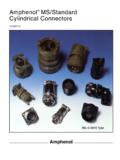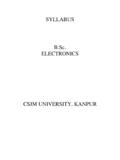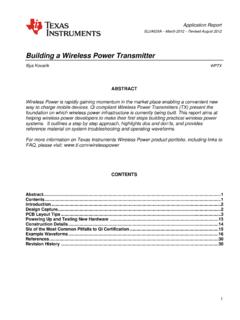Transcription of Electric Detonators used in Wireline operations - logwell.com
1 August 7, 2007. Electric Detonators used in Wireline operations The information included in this document is intended to inform the users of Electric Detonators in Wireline operations of their construction and function. A clear understanding of this subject hopefully will help with the determination of the various types of failures that can occur, how to diagnose and resolve them without catastrophic results. All illustrations are generic and are not intended to represent or endorse any particular manufacturer or their product. Some of the details have been obtained from the public domain and credit for them belongs to the owner/manufacturer. Titan does not manufacture Electric Detonators (with the exception of the specialized Igniters used in Setting Tool operations ). Basic Power Requirements/Specifications: No Fire.
2 2 amps ( Electric current applied to the device for I minute will not produce initiation). Minimum Fire: .5 amps ( Electric current applied to the device will result in a 95% probability of initiation). All Fire: .8 amps ( Electric current applied to the device will result in a 100% probability of initiation). Static Sensitivity: MIL-STD-322B (Standard used to define the energy expressed in millijoule or mJ). Firing current and non-resistorized vs. resistorized Detonators : Devices used in the industry today include those with a nominal circuit resistance of 1, 55, or 120 Ohms. Using these values, the specifications listed above are expressed in a usable format as: Voltage @ 1 Ohm Voltage @ 55 Ohm Voltage @ 120 Ohm .2 amp No Fire .2 Volts 11 Volts 24 Volts .5 amp Minimum Fire .5 Volts Volts 60 Volts .8 amp All Fire .8 Volts 44 Volts 96 Volts 11785 Hwy 152 Box 2316 Pampa, Texas 79066 Tel Sales Fax Page 1 of 8.
3 As you can see, non-resistorized Detonators require a significantly lower voltage to initiate as compared to resistorized styles. Most manufacturers use No-Fire and All Fire values in their technical specifications. Graphic illustrations of the internal components and their arrangement are located in another section of this document. Although the API RP67 specifically recommends the use of resistorized Detonators , the use of non-resistorized Detonators prevails today. Static Sensitivity: It is recognized that the human body can store a significant amount of static energy. This stored energy can cause Electric detonator initiation if the energy is dissipated from an internal component of the detonator (through the lead wires) through a sensitive explosive component to the outer shell. An industry method of determining a device's sensitivity is specified in great detail in the MIL-STD-322B and the value is expressed in mJ (or millijoules).
4 A layman's description of this can be found at the following website For relative comparison, a 1 ohm detonator has a value of 78 mJ compared to a 55 ohm version which has a value of 781. mJ. The most common way to bleed off the energy is through the use of a conductive rubber plug installed by the manufacturer in the end of the detonator. Bared sections of the leg wires pass through the rubber plug creating a leak path to the outer shell (see illustrations later on in this document). Basic Construction: Figure 1, Non-resistorized: The basic components of a non-resistorized Electric detonator are illustrated here. This design contains a bridge wire buried in a sensitive ignition mix (typically Lead Azide) which is in intimate contact with a less sensitive secondary explosive (RDX, HMX or HNS). Primarily this design is used where fluid exposure is not anticipated.
5 11785 Hwy 152 Box 2316 Pampa, Texas 79066 Tel Sales Fax Page 2 of 8. Figure 2, Resistorized The addition of two 27 Ohm resistors (one in each leg wire) for current limitation is the primary difference between Figure 1 and Figure 2. Two resistors are used to overcome space constraints. Figure 3, Resistorized In this example a single resistor (typically 55. Ohm) is used instead of the twin resistors and bridge wire. Figure 4, Resistorized, Fluid Disabled In this example (G-21 style), a 120 Ohm resistor is in close contact with a sensitive, primary explosive (Lead Azide). One side of the lead wire is insulated and the other is not. If fluid comes in contact with the resistor it is cooled and prevented from generating enough heat to initiate the Lead Azide. The explosive is also rendered useless if the exposure is of sufficient duration.
6 11785 Hwy 152 Box 2316 Pampa, Texas 79066 Tel Sales Fax Page 3 of 8. Figure 5, Resistorized, Fluid Disabled An alternative to Figure 4 is the Block Detonator . It uses an Electric Detonator and a Secondary Non- Electric Detonator separated by a Fluid Tunnel . The detonating cord is threaded through the Block adjacent to the Non- Electric Detonator as shown. Fluid (or debris). present in the Fluid Tunnel will attenuate the energy from the Electric Detonator, preventing initiation of the Non- Electric Detonator. Figure 6, Alternative Design Referring to the designs illustrated in Figure 1, 2 and 3, an alternative ignition system using a Fusehead (bridge wire coated with a pyrotechnic) is commonly used today. In the previous designs, to introduce fluid disabling of the device, ports are located in the chamber adjacent to the Bridge Wire.
7 In the Fusehead style, the coated bridge wire is located in a chamber that separates it from the Ignition Mix. Ports located in the chamber area provide a path for fluid to enter into the assembly. The fluid will prevent to generation of the flame formation at the Fusehead or its projection into the ignition mix located at the other end of the chamber. Why 55 Ohms? Many have pondered over the reason behind the use of a 55 Ohm circuit resistance in these Detonators . The original target for the minimum firing current was .25 amps. At that value and a circuit resistance of 55 Ohms, it required volts or more to fire bridge wire Electric Detonators with this feature. This voltage level was above the commonly found 12 volt battery (and its charging system) used in and around the wellsite that was recognized as the greatest exposure hazard at the time.
8 11785 Hwy 152 Box 2316 Pampa, Texas 79066 Tel Sales Fax Page 4 of 8. Fluid Resistant vs. Pressure Resistant: Fluid Resistant Detonators usually have a low value such as 150 PSI and are used in the primary side of the Block Detonator. Because there is another mechanism to prevent the initiation of the rest of the explosive train it is not necessary to utilize a more complex device, thus lowering the cost. Pressure Resistant Detonators are constructed in such a manner to provide for the mechanical attachment of the detonating cord to the detonator while providing an environmental seal to prevent the intrusion of wellbore fluid into the assembly. Typical pressure resistance values are 10,000 22,000 PSI, depending on the detonating cord specifications and time exposure at pressure and temperature. Fluid Sensitive vs. Fluid Disabled: These terms are used to describe the relative sensitivity of the detonator when exposed to fluid.
9 Generally speaking, Fluid Sensitive means that the device will be rendered useless after a period of time. At ambient conditions, the time exposure can be anywhere from a few seconds to several minutes, depending on the construction of the device. For instance, the example shown in Figure 6 is designed to not function as soon as fluid enters the chamber AND wets the Fusehead. Another style of detonator not shown contains a hygroscopic shock disk that separates two components of the detonator (most commonly the Primary and Secondary Explosive). Fluid must saturate the disc to attenuate the shock wave from one component to another or wet out the Bridge Wire or Fusehead. Fluid Disabled is usually associated with the style illustrated in Figure 5 where the presence of fluid in the Fluid Tunnel prevents the transfer of the shock wave to the Non- Electric Detonator and is meant to be instantaneous.
10 Because these terms can be and are used interchangeably, the user must review the technical specifications of the device he will be using and decide which one will best fit the application. For instance, if the application calls for the use of a single hollow carrier, several styles can be used . If a seal failure is experienced, the detonator should be disabled while running into the wellbore before you attempt to fire the device. If you are running a selective fire assembly and fluid enters the next gun after firing the first gun, the detonator may not have enough fluid time exposure before you attempt to fire it. The result is a ruptured gun that was partially filled when it was fired. General Sensitivity of All Styles (containing Primary and Secondary Explosives): If electrical energy is applied to the detonator in excess of the No-Fire level, it will fire.








